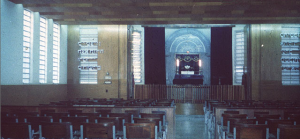
Photo: Synagogue in San Salvador, 1975, courtesy of The Museum of the Jewish People at Beit Hatfutsot
This year the Latina/o Diaspora in the Americas Project (LDAP) expects to finally complete the transcription of the History of Jewish Community in El Salvador project, through a collaboration with Dr. Rebecca Jefferson of the UF Judaica Library and thanks to funding from the Library’s NEH Challenge Grant. The collection documents the community-building efforts of Jewish immigrants to El Salvador, some arriving in the 1920s and starting coffee plantations, and many more arriving after fleeing the Nazi occupation during WWII.
The Jewish Community in El Salvador Since 1945
The presence of Jews in the Americas is as old as Columbus’s so-called discovery of the New World. In the same year as Columbus arrived in what is now the Bahamas, groups of Sephardic Jews, and Crypto-Jews joined expeditions to the Americas after the 1492 expulsion of Jews from Spain by royal decree.
The term “Cryto-Jews,” meaning secret Jews, was used during the Spanish Inquisition as an accusation against those of Jewish origin living in Spain and Portugal, who had converted to Christianity. Although many of these individuals were from families that had been practicing Catholics for decades or—in some cases—centuries, they were accused of still following Judaic practices in private. After Jews were fined, prosecuted, or tortured by the Spanish Inquisition, many thought they could find freedom if they departed for the Americas.
By the late sixteenth century, there were fully functioning Jewish communities in Brazil, Santo Domingo, Jamaica, and other areas of the continent. Here at the Samuel Proctor Oral History Program, we are documenting the presence of Jewish populations in Latin America during more recent eras, with a current focus on the Jewish community in El Salvador since 1945.
Arriving a few years after El Salvador became an independent country, it is thought that the first Jewish immigrant was the Alsatian-born Bernardo Haas. Subsequently, the first documented German Jew arrived in the country in 1888, according to scholar Jessica Alpert. France and Central Europe were the main countries of origin for this contemporary Jewish migration.
Commercial business, banking, and similar economic activities have been the main occupations of Jewish members of the small Salvadoran community. Max Freund, for example, became the first president of the community in 1943, and his family’s hardware business continues to be in operation to this day. For that matter, the Jewish community in El Salvador has much in common with the Palestinian population of the Central American country. Both groups often share financial enterprises, as well as family links through marriage.
A major shift began to occur by the 1930s, when the migrant policy of the country became stricter. In 1936, members of the Jewish community in El Salvador attempted to help their relatives escape from Europe. However, on July 30,1939, fifty Jewish refugees bound for El Salvador were returned to Germany. In many Latin American countries, Benito Mussolini, and Adolf Hitler were venerated, until the defeat of both countries by the spring 1945.
Immediately after World War II, the Salvadoran policy towards the Jewish world reverted back to being more open. On September 11, 1948, this shift culminated in the Republic of El Salvador recognizing the State of Israel. For years, El Salvador was one of only two countries to maintain an embassy in Jerusalem, until 2006. The good diplomatic relationship probably assuaged the self-imposed exile that brought many Salvadoran Jews to Israel in the late 1970s and 1980s.
Many of these experiences—war in Europe and Salvadoran Civil War—are repeatedly remembered in the collection of interviews archived by SPOHP. These valuable documents are the product of research conducted by Fulbright Scholar Jessica Alpert, who spent a year collecting the oral histories of the 60 families of the Jewish community of El Salvador. The transcribed and edited interviews are primarily in English and Spanish, with a few in French. Indeed, almost all of the families were from France or Tunisia and, after moving to El Salvador, became connected to the United States of America through their children, or through their escape from the war in the 1980s. In addition, a few members converted from Christianity to Judaism.
— Francesc Morales and Aliya Miranda

